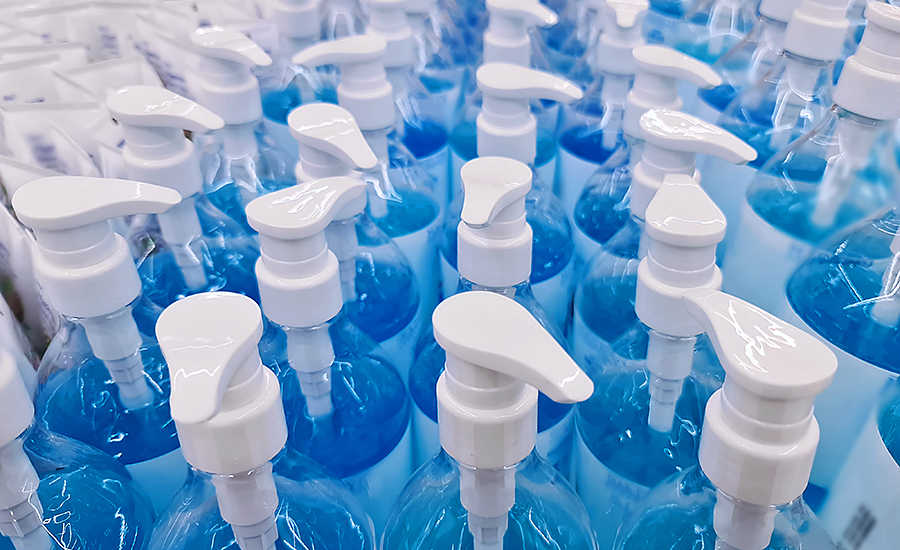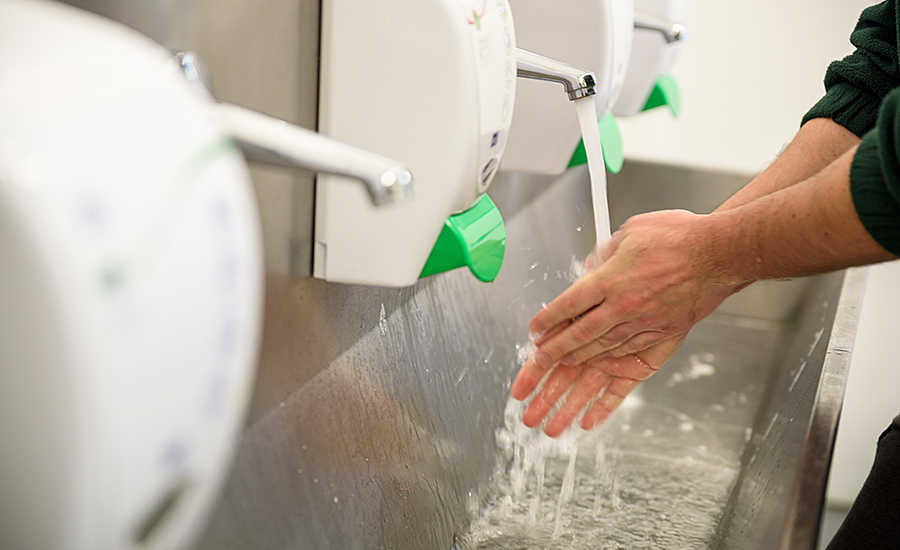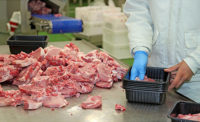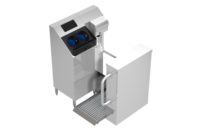Employee hygiene in packing plants is now not just about protecting food, but protecting employees.
The coronavirus disease 2019 (COVID-19) has infected 4,913 employees at meat and poultry processing facilities — or 3 percent of that work force — with 20 deaths, the Centers for Disease Control and Prevention (CDC) reported as of April 27. The data were provided by 115 plants in 19 states with 130,000 employees. About half a million workers are employed at meat and poultry processing facilities, noted the report.
These employees are uniquely vulnerable to COVID-19 exposure because of risks associated with working at meat facilities — lack of physical distancing, hygiene, reluctance to report being sick and crowded living and transportation conditions, the report showed.
The CDC report recommends plants improve physical distancing, hand hygiene, cleaning and disinfection and medical leave policies along with providing educational materials in languages spoken by workers.
“From a positive standpoint, most establishments had good sanitation before, but now they have increased their attention to employee hygiene practices and handwashing procedures,” says Kerri Gehring, Ph.D., a professor, and Presidential Impact Fellow in the meat science department at Texas A&M University, based in College Station, Texas. “They had a good foundation in place, but COVID-19 has emphasized the importance of hygiene and reiterated to employees why hygiene and sanitation was stressed for years.”
According to Gehring, many companies are providing masks in the workplace, with some giving masks to employees to take home and share with family members outside the work environment.
“Many companies are looking at how to protect employees in the plant and within their community,” Gehring says. “I also know of at least one establishment that has offered hand sanitizer for employees to take home as well.”
In the past, hygiene training emphasized why sanitation was important to protect the product, but now it also stresses that it’s to protect the employee’s family.
“Hygiene was something some may have taken for granted, but COVID has shown why we shouldn’t,” says Gehring. “Handwashing is not something we can do too often.”
The CDC report also recommends allowing employees access to handwashing stations and alcohol-based hand sanitizers if handwashing isn’t possible.

Also, face masks or personal protective equipment (PPE) now need to be treated the same as gloves. Workers have to know when and how to change them, as their care is just as important. Face shields can also serve as PPE and improve source control.
“Face masks can either be washed or thrown out,” says Mel Kramer, Ph.D., CEO at EHA Consulting Group, based in Baltimore, Md. “We have to train employees on how to put masks on properly, take them off and throw them out.”
Face coverings should be worn in nonproduction areas such as entrances, exits, break rooms, shared vehicles and other areas where it’s difficult to social distance, says the CDC. It’s also important to consider their potential for contamination and when they should be replaced.
As always, it’s ideal if work uniforms can be left at work to be cleaned and street clothes can be worn only in the street.
“Most plants follow CDC guidelines to implement hygiene procedures,” Gehring says. “I’ve heard of one or more that have recently improved employee education with signage on how to wash hands, wear masks and change them.”
Many companies also insist “employees be temperature-checked, answer questions on if they have been around those with COVID, and try to distance people in meat packing facilities and retail establishments,” Kramer says.
Employee hygiene has evolved to focus more on health and behavior. “There’s always been rules about not coming to work if you’ve had a fever, diarrhea or a cough,” Kramer says. “Now, if an employee has contact with someone with COVID, they are out 14 days.”
That’s a price that’s easier for large companies to pay, but not for small facilities. “One of our current (public health) failures is the lack of tracking/contact tracing,” Kramer says. “This spills over into the work environment.”
During the pandemic, as meat processing facilities, restaurants and subways, for example, are cleaned more thoroughly, the public may ask why this wasn’t done before, Kramer says.
“Is this the new benchmark going forward?” says Kramer. “People will demand a higher level of cleanliness in the future, as well.”
Increased attention on taking precautions, such as taking temperatures and social distancing, may be here to stay, says Kramer — or should be.
Even as things return to “normal” one day, “we have to always remember we can’t let our guard down,” Gehring says. NP
Guidance on preventing COVID-19
To protect workers and the food supply during the COVID-19 pandemic, the Occupational Safety and Health Administration (OSHA) and Centers for Disease Control and Prevention (CDC) recently issued joint guidance on precautionary measures for meat and poultry processing facilities. Here are some key ideas:
Increase distance between workers: Meat and poultry processors have trouble social distancing because they often work closely together on processing lines, when clocking in or out or when in locker/changing rooms.
Shorten long shifts: Meat and poultry workers can work 10- to 12-hour shifts.
Wear face coverings and sanitize hands: Workers have many opportunities to be exposed to the virus through respiratory droplets in the air, contaminated surfaces or objects and shared common spaces.
Reduce carpooling: Employees may ride-share or carpool to work or take public transportation, which increases their risk of COVID-19 exposure.





Report Abusive Comment